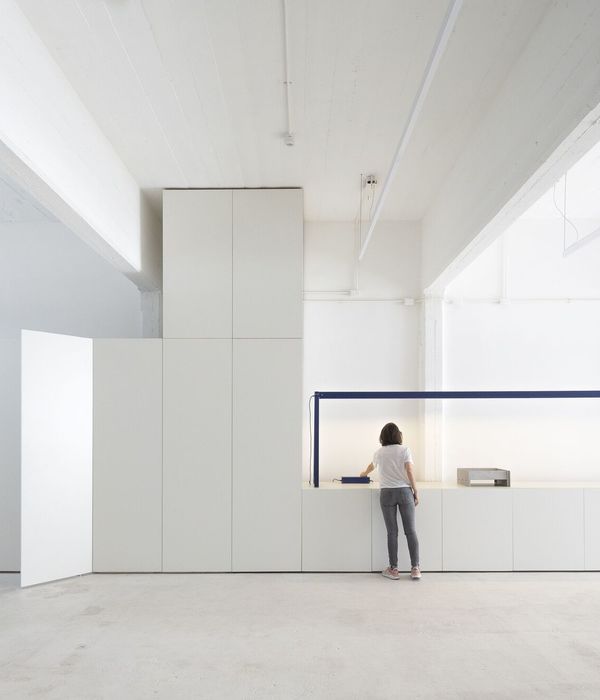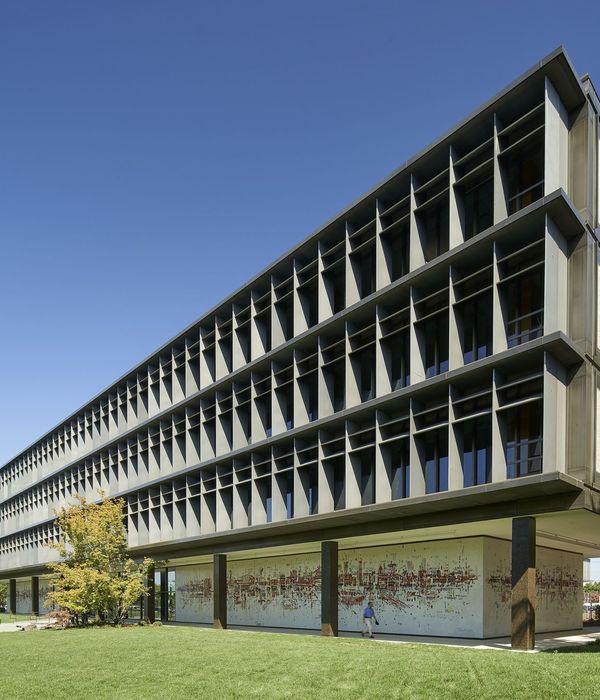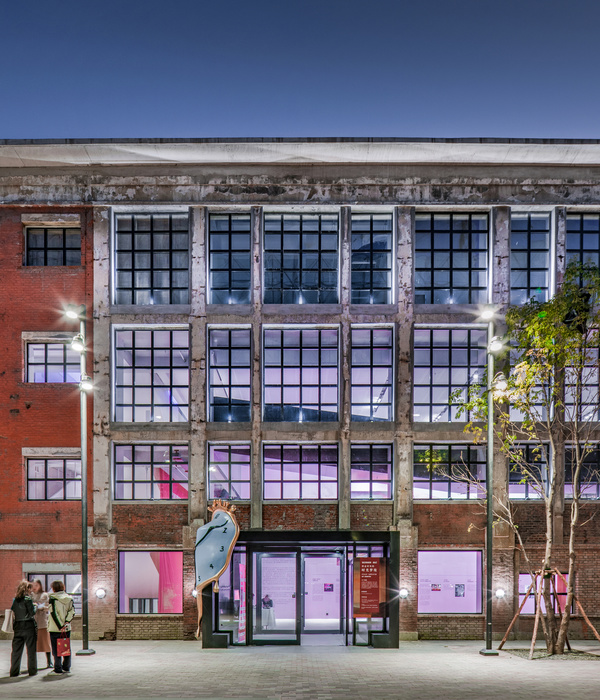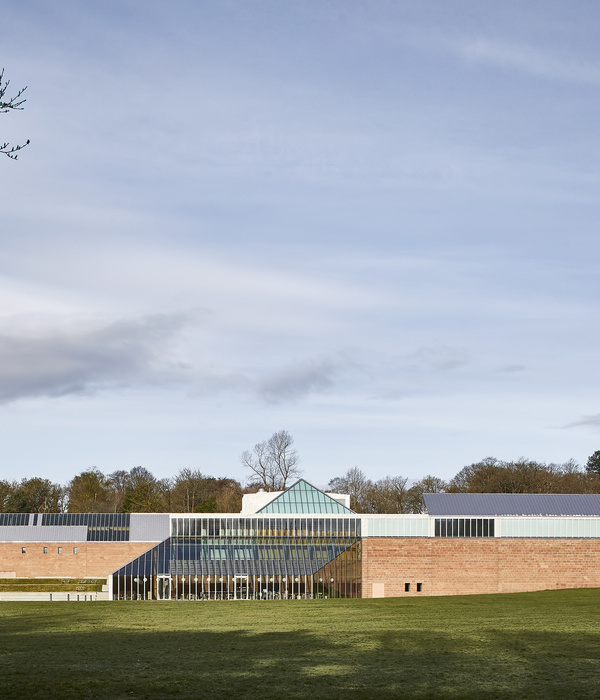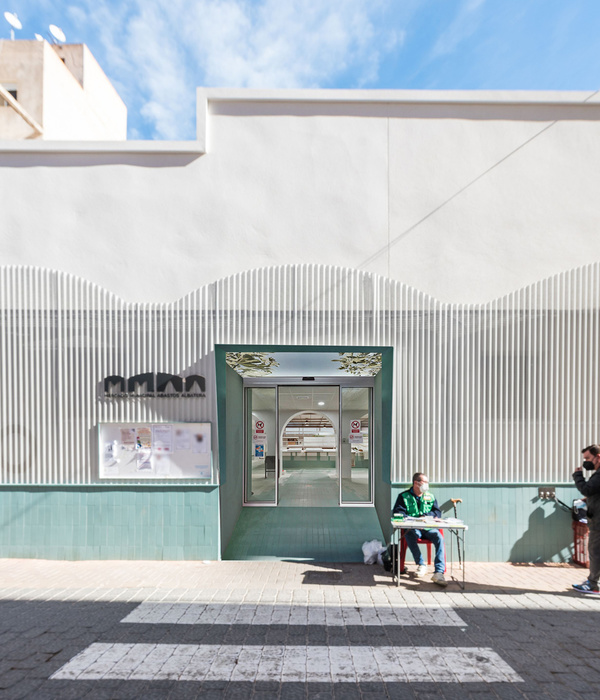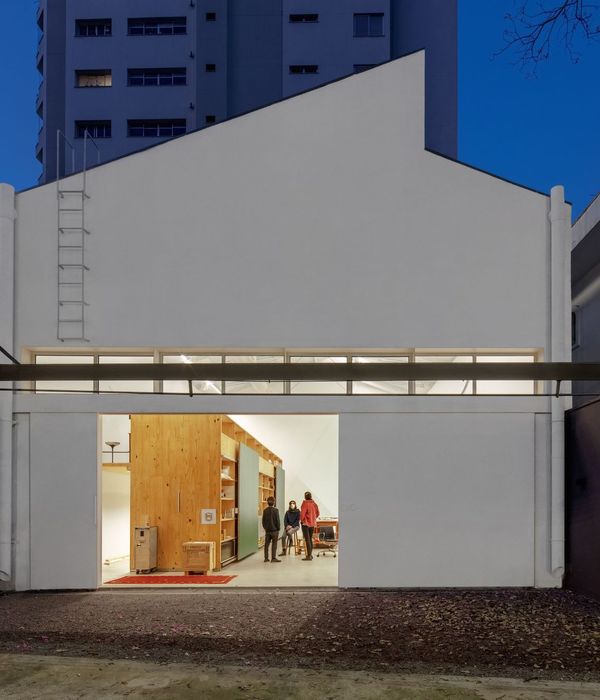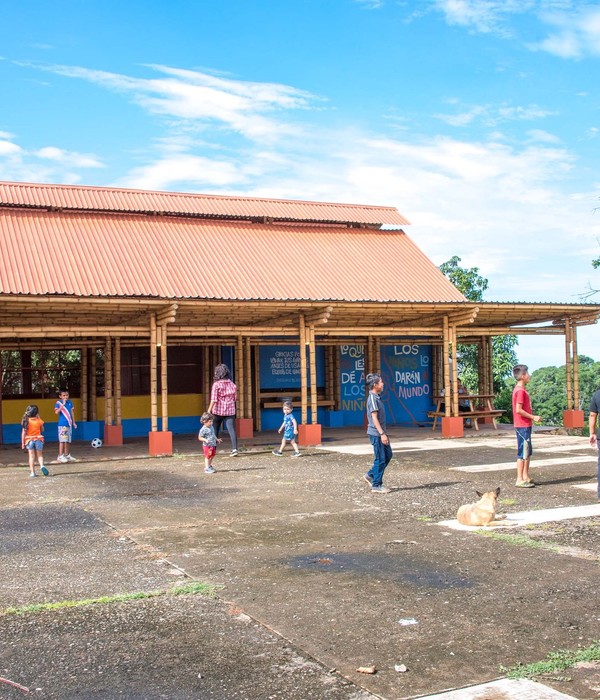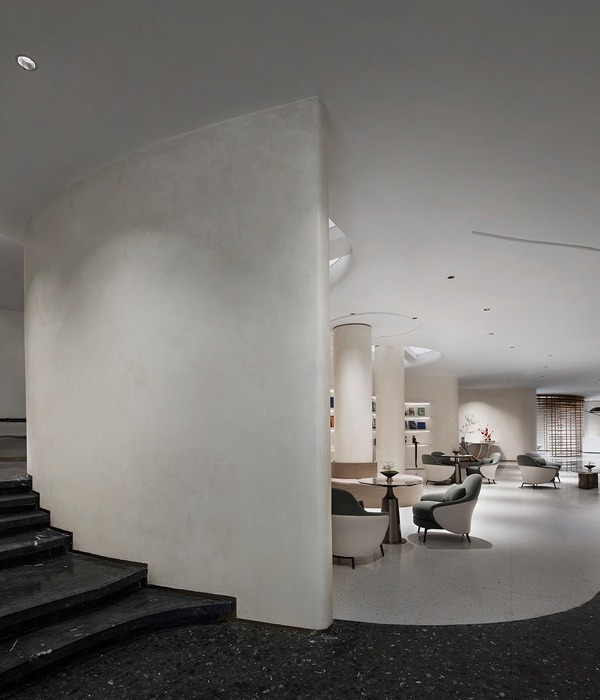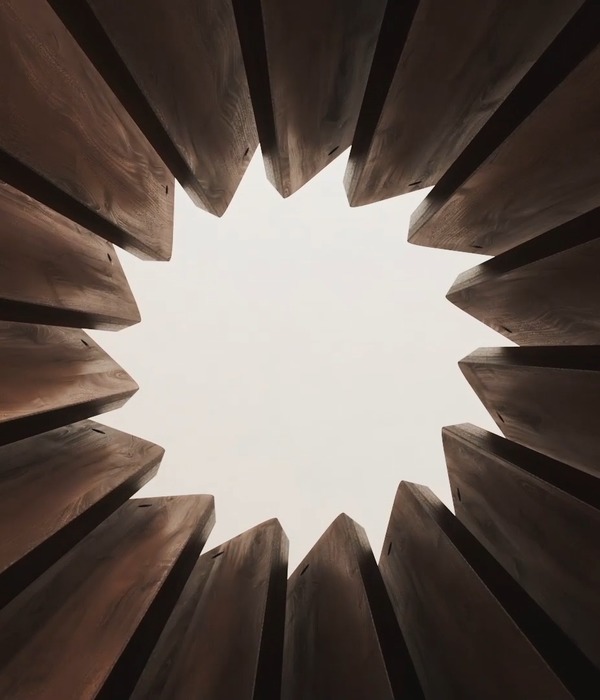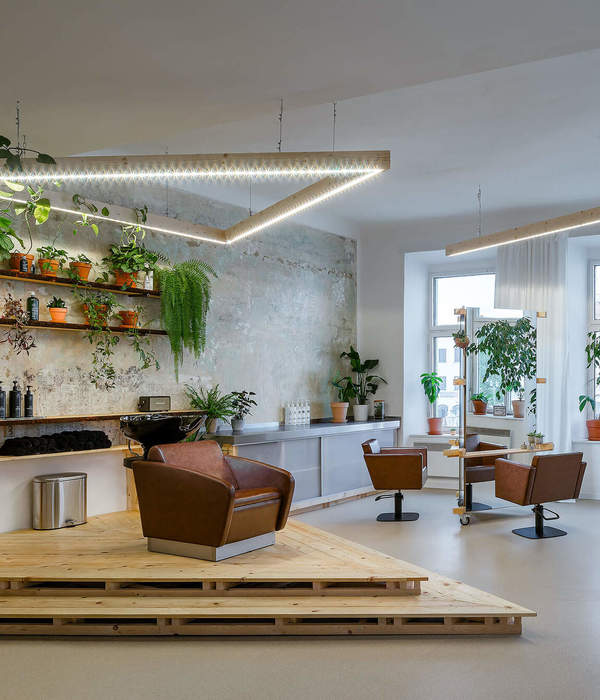Sandy Bodecker于2017 年成立了NM Bodecker基金会,旨在为创意群体提供用于研讨与聚会的灵活空间。基金会对一座1950年代的仓库和一处旧停车场进行了改造,实现了Bodecker最初设想的创意之家。Bodecker以旅途中的新发现和看待事物的新角度为灵感,构想了以“迷宫”为概念的建筑。
The NM Bodecker Foundation was established in 2017 by Sandy Bodecker to provide creative communities with a dynamic mix of in-person spaces for workshops, gathering, and collaboration. Housed in a collection of repurposed 1950s-era warehouses and a former parking lot in northwest Portland, the Foundation occupies what was originally conceived as Bodecker’s creative home. Bodecker was inspired by the sense of discovery that comes from the journey and of seeing things in new ways; his analog was that of a labyrinth and the building is an embodiment of that idea.
建筑师对旧仓库进行整合与重组,在室内外构成了一系列变化的环境。团队从戈登·马塔·克拉克 (Gordon Matta Clark) 的“建筑剪裁”理念中汲取灵感,对仓库进行了剪裁与改造,将历史边界保留下来,通过屋顶的“剥开”与“切割”将仓库空间进行混合重组,赋予其新的核心。
The warehouses were combined, integrated, and reworked into a shifting mix of exterior and interior environments. Taking a cue from Gordon Matta Clark’s “Building Cuts,” the warehouses were cut into and modified while retaining the memory of their historic boundaries. Peeling back the roof of one and slicing the other, the warehouses were remixed and fused together with a new central core building.
▼项目概览,overview of the project © Jeremy Bitterman
这座总面积约722平方米的多层建筑包含了起居区在内的室内空间,以及一系列非正式的表演空间、录音室与室内滑板公园。扩建部分包含作为活动场地的屋顶与约186平方米的室外庭院,保留绿地达项目的三分之一,使建筑与自然环境紧密地联系在一起,并支持对雨水进行收集与利用。从街道看去,长方形的仓库与交织的梁架构成了平衡,营造出丰富的视觉效果。
The 7,769-square-foot multi-story solution blends the past with the future through the interplay of interior spaces including living areas, as well as a series of informal performance spaces, a state-of-the-art recording studio, and an indoor skate park. The build-out includes living roofs and nearly 2,000-square-feet of outdoor yards—a third of the site kept as green space to manage stormwater and connect the complex with the natural world. From the street, the rectangular warehouse forms are balanced with complex prismatic forms to create a rich visual composition.
▼街道视角,view from the street © Jeremy Bitterman
在创始人Bodecker于2018年离世后,基金会接管了整座建筑,面向年轻的艺术家、表演者、志同道合的组织以及创意协作社区开放这些独特的空间组合。创造一个激发探索与学习欲望的环境是Bodecker的目标之一,人们将在这里重新找回孩童时期的好奇心。不同的活动拼贴、相交与重叠,激发了人们对收藏、制作与玩耍的热情。
Following Bodecker’s passing in 2018, the Foundation fully occupied the building, embracing the unique mix of spaces and making them available to emerging artists and performers, like-minded organizations, and the collaborative creative community. One of Bodecker’s goal was to create an environment that inspires openness to explore, learn and find the unlimited curiosity you once had when you were a kid. The collage of activities intersect and overlap to inspire a passion for collection, making, and playing.
▼建筑立面,the facade © Jeremy Bitterman
▼室外庭院,the courtyard © Jeremy Bitterman
▼屋顶活动空间,the living roof © Jeremy Bitterman
从这些想法出发,建筑师将新的多层中央空间作为基金会的功能核心,在底层形成互相敞开的大空间,为艺术创作、音乐录制、表演和滑板提供了场地。为艺术家“驻留计划”而设置的生活空间布置在二层和三层,可俯瞰下方活动,建立起联系。
By developing the program around these ideas, the new multi-story central structure emerged as the functional core of the foundation. The primary spaces open to each other at the ground floor with places to make art, record music, perform, and skate. The living spaces for the artist-in-residence program are stacked above on the second and third floors, overlooking but still connected to the activity below.
▼形成通高空间,creating a double-height space © Jeremy Bitterman
▼室内滑板公园,skate park © Jeremy Bitterman
建筑材料既有拆除后保留的回收元素,也有让人眼前一亮的的现代饰面。综合大楼内的新建区域凸显了具有现代感的审美,与陈旧的复古元素相映成趣,构成了明暗对比。室内空间的饰面由丰富的颜色和质地构成,外露的木桁架、混合地毯图案、钢与未经修饰的胶合板墙面与定制照明相互交织,增强了空间活力。这些材料的选择遵循一致的原则,传递着自然老化的魅力与匠人的精心工艺。
Building materials range from repurposed elements preserved from demolition to surprising contemporary finishes. New-built areas within the complex are contemporary in aesthetic, providing a yin-yang vibe when viewed against the time-worn patina of the vintage elements. Interior finishes throughout embrace color and texture—exposed wood trusses, mixed carpet patterns, steel and unfinished plywood wall cladding, and custom lighting—further enhancing the spatial dynamism. Materials were selected for their internal integrity, their ability to age naturally, and convey the craft of those who made them.
▼开放的会议空间,the open meeting space © Jeremy Bitterman
▼楼梯视角,view from the stairs © Jeremy Bitterman
▼屋顶活动区,living roof © Jeremy Bitterman
▼望向休息空间,view of the rest room © Jeremy Bitterman
▼录音室,recording room © Jeremy Bitterman
项目旨在激发与创造活动,通过独一无二的环境促进人与现实和虚拟的积极互动,以开放且富有创造性的对话回应博德克基金会成立的内涵。
At its core, the building design aims to inspire action and activity. The unique environment seeks to create meaningful engagement (both in-person and virtual). Open and creative dialogue is at the heart of why the Bodecker Foundation was established.
▼夜景,night view © Jeremy Bitterman
▼总平面,general plan © Jeremy Bitterman
▼首层平面,the 1st floor plan © Jeremy Bitterman
▼剖面图,sections © Jeremy Bitterman
Skylab Design Team Jeff Kovel, Design Director Brent Grubb, Project Manager Jamin AAsum, Project Architect Kyle Norman, Project Architect Dustin Furseth, Project Architect Amy DeVall, Interior Designer Stephen Miller, Design & Visualization
Project Team Architecture: Skylab Architecture Interior designer: Skylab Architecture Contractor: Skylab Construction Co. Civil Engineer: Harper Houf Peterson Righellis Inc. Structural Engineer: Structural Engineering (SCE) Mechanical / Electrical / Plumbing Engineers: Interface Engineering Geotechnical Engineer: Geo Design Landscape: 2.ink Studio Lighting: Lighting Workshop Acoustical Engineer: Coral Sound Inc. AV: Ambient Automation Code: Code Unlimited Low Voltage: Ambient Automation Soils Engineer: GeoDesign Inc. Building Envelope & Waterproofing: The Facade Group Recording Room Consultant: Michael Cronin Acoustic Skatepark Consultant: Dream Land Skateparks
Photography Jeremy Bitterman Stephen Miller (video)
▼项目更多图片
{{item.text_origin}}


